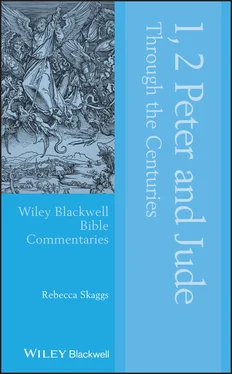1 ...8 9 10 12 13 14 ...21 Later, Calvin would use this passage as one of the preeminent supports for his doctrine of election:
Hence when Peter calls them elect according to the foreknowledge of God, he is showing that the cause of it depends simply on God alone, because he of his own free will has chosen us. Thus the foreknowledge of God excludes every worthiness on the part of man (Calvin, Comm ., 1963: 230).
In contrast, Arminius reads vv.1–2 as a refutation of Calvin’s thesis of foreknowledge as election. He defines “foreknowledge” as the knowledge of something before it happens. Although God knows who will believe, he does not cause it; those whom he foreknows, he also elects to be saved (for the first translation from the Dutch and explanation of Arminius’ Declaration of Sentiments , see Stephens, 2012).
John Bengel (1687–1752), a learned German exegete, wrote a commentary on the whole Bible which has influenced and continues to influence biblical scholars. He points out that Peter’s words on foreknowledge here (along with v.20) are broad concepts, incorporating also good‐will and love; in fact, he understands this reference to include the mystery of the Trinity as a summary of the entire epistle (1981: 727). We see little if anything of the controversial issues to come. Peter will address this issue in more detail later in the epistle.
John Wesley goes further and sidesteps the entire issue of sovereignty and free will: “there is no foreknowledge or after‐knowledge. All is present to God” (WesleyCenterOnline: ccel.org).
Several later faith groups have made strong statements about the implications of this position. For example, the Mennonite Articles of Faith (1766/1895/1902) go so far as to contend that:
It is therefore contrary to the renewed nature of the believers and in antagonism with it, to sin. Moreover, they are carefully watched over and kept (1 Pet. 2:25). (Pelikan, vol. III, part V: 172)
The Declaration of Faith of the New Hampshire Baptist Convention (1833–1853) more generally maintains that, “We believe that election is the eternal purpose of God, according to which he graciously regenerates, sanctifies, and saves sinners” (Pelikan III, V: 245). The Confessional Statement of the United Presbyterian Church emphasizes the process of sanctification more than the nature of election.
Thomas Vincent (1634–1678), an English Puritan minister and author, ascribed to the reformed theory of election, but was evidently most interested in sanctification. He describes the process in some detail, maintaining that it is present in all Christians, but is further developed in them over time. For example, “True Christians are sanctified wholly, in their whole man, though they be not sanctified thoroughly … Their whole spirit is sanctified, that is, the higher faculties of the soul, namely, the understanding and the will” (1812: 19–20: digitalpuritan.net).
Some modern scholars take this reference to God’s foreknowledge in the context of the epistle as a whole, with its emphasis on the readers being estranged because they are “chosen” by God. In this light, “God’s foreknowledge” is emphasizing that they are not enduring random suffering, but are indeed part of God’s preordained plan and purpose (there is a similar concept in 1 Pet. 1:20, Acts 2:23; Rom. 8:28–30, 11:2). Throughout 1 Peter this is underscored by the concept of believers being identified as “called” ( kletois ) (see 1 Pet. 1:25; 2:9, 21; 3:9; 5:10), that salvation through Jesus Christ is part of God’s preordained plan (Elliott, 2000: 318–319). Hence, the alienation resulting from becoming God’s “chosen” is also preordained.
Verse 2 alludes to an early Trinitarian pattern of the threefold manifestation of the Godhead which was to dominate all the later creeds, such as the Apostles’ Creed (late second century) and the Athanasian Creed (sixth century) (see Kelly, 1950: 22–23). Although there are also Pauline examples of this pattern, 1 Peter 1:1–2 stands out as a clear “stereotypical tag or cliché before the third generation of the first century” (Kelly, 1950: 21). With some modifications, this emphasis on the work of the members of the Trinity continues into later times.
The Heidelberg Catechism (1563) cites 1 Peter 1:1–2 in answer to Question 70, about the meaning of being washed in the blood and Spirit of Christ. The Catechism states: “it means to have the forgiveness of sins from God, through God, for the sake of Christ’s blood which he shed for us in his sacrifice on the cross.” Note that the Catechism omits “through the sanctifying work of the Spirit” from v.2, substituting the more general “through God” (Pelikan II, IV: 442).
A number of hymns have been influenced by this passage, for example, Blest be the Everlasting God (1707) and Bells of Hope (1905). In particular, Blest be the Father and his Love (1709), written by the prolific hymn writer Isaac Watts (1674–1748), reflects the work of each member of the Trinity. Paraphrases (not direct quotes) are highlighted in bold:
Blest be the Father and His love,
To whose celestial source we owe
Rivers of endless joy above,
And rills of comfort here below.
Glory to Thee, great Son of God,
From whose dear wounded body rolls
A precious stream of vital blood,
Pardon and life for dying souls.
We give the sacred Spirit praise,
Who in our hearts of sin and woe
Makes living springs of grace arise,
And into boundless glory flow.
Thus God the Father, God the Son,
And God the Spirit, we adore;
That sea of life and love unknown,
Without a bottom or a shore.
( cyberhymnal.org).
The grace‐and‐peace blessing is a Christian adaptation of the secular peace blessing and is found in virtually all of the New Testament epistles, as well as in many other letters of the early church. In 1 Peter, the unique feature is the word “abundance” ( plethyetheie ) used here in the optative, which Paul never includes in his peace blessings. The sense, then, is “May your peace be great!” (Michaels, 1988: 13). This use certainly influenced 2 Peter and Jude, as well as 1 Clement and Polycarp (Philippians and Martyrdom). Throughout 1 Peter, the theme of grace is what conveys on the readers their privileged status with God (1:2, 10, 13; 3:7; 4:10; 5:5, 10, 12. cf., 2:19, 20). At the end of the epistle (5:10, 11), the grace‐and‐peace blessing is reiterated, forming an inclusio .
The Meaning and Purpose of Suffering (1:3–10)
Overview
Mercy, hope, and joy are three of the overarching themes of 1 Peter interwoven in his discussion of suffering. This passage is composed of three sentences, presented in such a way as to lead some scholars to identify it as a hymn. It is divided rhythmically into five stropes of five to seven lines each (for details, see Windisch and Priesker, 1951: 52; cf. , Goppelt, 1993: 79). “Hope” is first introduced here:
vv.3–5 praise for God who has brought us to a living hope .
vv.6–7 hope in spite of suffering.
vv.8–9 hope although salvation cannot be presently seen.
Additional important concepts of 1 Peter are seen here: suffering, God’s mercy, and future eternal rejoicing promised to the chosen of God, with hope underlying the entire passage.
Peter’s notion of what God has done through Christ is based on the inalterable precept: God, out of mercy, has become Father to all, whether Jew or Greek, who acknowledge Christ as Lord. The use of “mercy” strongly echoes its Old Testament predication as an attribute of God (e.g., Num. 14:18; Pss. 86:5, 15; 104:8; 145:8; Joel 2:13). For example, Psalm 65[66].20 [LXX] says, “Blessed be God who has not turned away my prayer, nor his loving kindness from me.” By means of “mercy” God unites both Jew and Gentile in the rebirth made possible through Christ’s death and resurrection. In this way, Peter links mercy to “grace” which is given by God, but it is mercy which motivates the giving, the quality inherent in God as God.
Читать дальше












